Categories of roads by types of coverage. The main types of road surfaces
Highway consists of subgrade and pavement. road clothes represents a multi-layer structure and includes layers of coating and base. Coating- the top durable layer, which is well resistant to abrasion and shock loads from car wheels, as well as to the impact natural factors. It consists of a wear layer and a main (bearing) layer.
Base- bearing strong part of the pavement, consisting of several layers, arranged from stone material or soil treated with a binder.
The choice of the type of pavement, which usually costs 40-60% of the total cost of the road, is an important and responsible decision. The higher the technical category of the road, the higher the requirements for the strength and solidity of the pavement.
Car roads according to their importance in the general transport network of the Republic of Belarus and depending on the average daily traffic intensity of cars, they are classified into five technical categories:
Iа – traffic intensity more than 14000 vehicles/day.
Ib - traffic intensity 14000 - 7000 vehicles / day.
II - traffic intensity 7000 - 3000 vehicles / day.
III - traffic intensity 3000 - 1000 vehicles / day.
IV - traffic intensity 1000 - 100 vehicles / day.
V - traffic intensity less than 100 vehicles / day.
Coatings, depending on the solidity of the structure, the nature of the movement and technical and economic indicators, are:
improved capital (cement-concrete, monolithic and prefabricated; asphalt-concrete, laid in a hot and warm state, etc.);
advanced lightweight ones (from crushed stone and gravel materials treated with organic binders, from cold asphalt concrete, etc.);
transitional (crushed stone, slag, gravel, from soils reinforced with binders, etc.);
lower (ground, improved by various local materials).
Typical pavement designs:
a - cement concrete coating; b - asphalt concrete pavement on a crushed stone base; c - asphalt concrete pavement on a concrete base; d - asphalt concrete pavement on the ground, reinforced with cement; e - crushed stone coating with a top layer treated by impregnation; f - gravel surface treated with bitumen by mixing on the road; g - gravel coating on a low category road, 1 - cement concrete; 2 - leveling layer of sand treated with bitumen; 3 - a layer of crushed stone, gravel or soil treated with a binder; 4 - frost protective layer from sand; 5 – fine-grained asphalt concrete; 6 - a layer of crushed stone; 7 - coarse-grained asphalt concrete; 8 - soil reinforced with cement; 9 - crushed stone treated with impregnation; 10 - gravel treated with bitumen; 11 - gravel
asphalt pavement occupy a leading position on the main roads. They have high transport and operational
performance, strong, durable, easy to repair. Their wear even with heavy and intensive traffic does not exceed 1 - 1.5 mm per year. Asphalt concrete pavements, depending on the type of foundation and traffic requirements, are arranged in one, two or three layers. The top layer must be durable, wear-resistant and waterproof. These conditions correspond to fine-grained and sandy mixtures containing mineral powder.
Hot coarse-grained and medium-grained asphalt concrete mixtures with or without mineral powder are used for the device of the lower layer of coatings.
Cement concrete pavements have the following advantages over other types of coatings:
high strength, which allows all vehicles to pass at any time of the year;
long overhaul period (30-40 years);
high coefficient of adhesion with the wheels of cars, which practically does not change when the coating is moistened:
light color coatings that increase traffic safety at night;
the duration of the construction season is longer than with the use of organic binders;
low wear of the coating, not exceeding 0.1-0.2 mm per year.
However, cement-concrete pavements have a number of disadvantages that hinder their use on roads. These include: big number transverse seams that impair the performance and evenness of the coating; difficulty of repair; impossibility to open movements immediately after covering, etc.
Cement concrete is also used for laying foundations for asphalt concrete pavements on roads with heavy and heavy traffic.
Cement-concrete pavement is arranged on the road in the form of a monolithic solid slab, divided into sections of various lengths by expansion joints or in the form of a prefabricated pavement from slabs prepared at the factory different size. In the latter case, work on the road is reduced to the installation of plates on a prepared base. Despite some advantages of this type of pavement, such as an increase in the duration of the season, construction, prefabricated concrete pavements are not used on main roads. This is due to major shortcomings that significantly worsen their transport and operational qualities.
In reinforced coatings, tensile stresses are partially or completely perceived by reinforcement. In such coatings, reinforcement is used in the form of metal meshes or steel rods with a consumption of 2 ... 5 kg / m 2 of coating.
Cement-concrete coatings are arranged with the same thickness over the entire width of the carriageway in one or two layers. Two-layer coatings are used to be used in concrete for the lower layer of less durable stone materials. The thickness of the upper layer in two-layer coatings is taken at least 6 cm.
The choice and appointment of a single-layer or two-layer coating are based on technical and economic calculations. The thickness of the coating layer is determined by calculation taking into account the category of roads and must be at least: for roads of category I - 22 cm; for roads of category II - 20 cm; for roads of category III - 18 cm. In two-layer coatings, the thickness of the upper layer must be at least 6 cm.
Motorists know best how important good roads. Often the welfare of the state can be judged by the condition of the carriageways and roads. The proverb that by all means you can get to Rome has a good reason. The transport system was very well developed in this province. From virtually every province, a hard paved road could reach Rome. Currently developed a large number of types of pavement. Many of them are already in use, others are under implementation. This article will detail each of them.
General concepts
Carrying out activities that are designed to improve the situation with regard to road quality is much more difficult than it might seem at first glance. They include the process of research and planning in relation to a specific area. To reduce costs, along with human resources, new pieces of equipment are constantly being introduced, which also speed up the flow of these processes. For example, in the past, when laying road decking from concrete slabs, molds were used that subsequently remained inside the road surface and could reduce its quality, as well as affect total costs. Removable formwork for paving is now used, which is used at several sites. The production lines that provide the supply of concrete have also been upgraded. At the same cost, it was possible to increase the amount of raw materials for pavement at the exit.
Up to a certain point, it was necessary to wait for a significant period of time until the finished pavement gained rigidity for the possibility of operation. Modern hardener additives have reduced the time to a minimum. A unique compaction scheme has also been developed with the help of additional equipment, which makes it possible to reduce the amount of water in the finished pavement, and, accordingly, accelerate hardening.
Components of the coating
The quality of the final coating depends on many factors. One of them is a natural substrate. More precisely, then we are talking about the soil that will be under the pavement. It is the first layer. In some areas, there may be a strong displacement of the surface soil, so you have to go deep to a certain level, which is more stable, and also make a larger layer of embankment. An important point when laying the roadway is to provide drainage. They promptly divert rain and other water, which, lingering, can lead to the destruction of the roadway. This especially happens during the cold season, when the liquid, freezing in the pores, expands and leads to asphalt deformation.
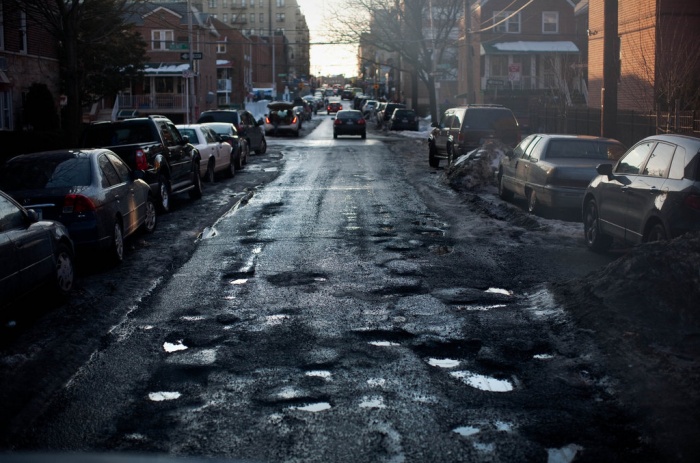
The width of the roadway includes not only the carriageway. The material consumption also includes roadsides where cars are parked. High-quality pavement consists of several types of layers. It is designed for a long service life. Such a pavement is expensive to manufacture, but less expensive to maintain since it has a long service life. With timely completion repair work Only the top layer is worn out. The lower layer of the road surface, which serves as a base and provides load-bearing properties, must remain undamaged, since a significant part of it will have to be repaved to repair it. Below the bearing cover is the base. In the pavement, it provides an even distribution of loads on the substrate or soil, which eliminates punching under the heavy weight of trucks.
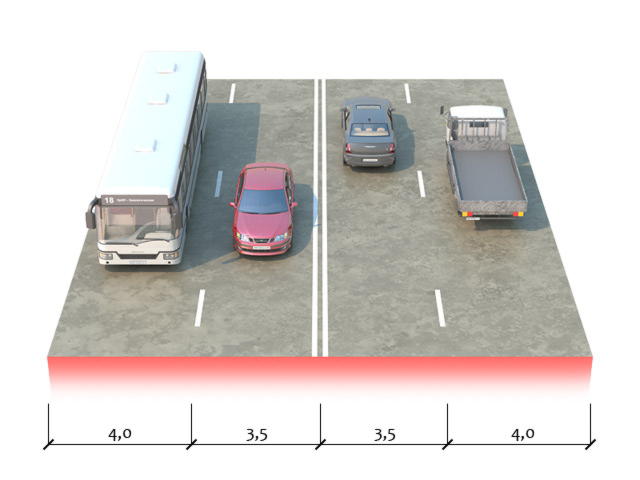
In areas where the temperature drops well below zero in winter time there is an additional layer to the base. Its task is to transfer the load and its distribution over the ground, as well as to ensure the stability of the entire pavement against the damaging effects of frost. In areas where significant precipitation is observed and water may be retained, there is a drainage layer that removes moisture from the canvas in a timely manner. For these purposes, the following can be laid: coarse-grained sand, crushed stone, soil, which is additionally processed with additives that improve its stability, crushed rock. Where these options are not available, local building materials are used.
Road classification
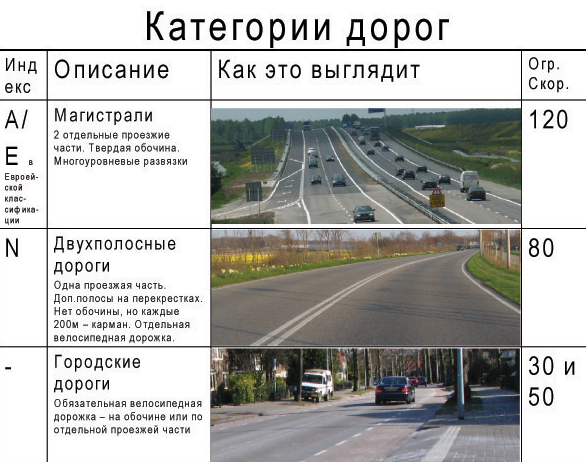
Roads are divided into several groups. It all depends on what kind of transportation they carry out and what significance they have in the region. An additional criterion is the maximum allowable speed of movement along them. Depending on this, there are:
- highway;
- high-speed highway;
- city road;
- dirt road.
The first and second types are similar both in purpose and in the coating used on them. They involve the movement of cars at considerable speed in several streams in one direction. At the same time, the directions are separated from each other special stripe or a bump stop, which eliminates the possibility of accidental entry into the oncoming lane. A city road or an ordinary road allows driving at speeds up to 90 km/h. At the same time, it can have one or two lanes in one direction. Intersections on the same level as other modes of transport are allowed on this type of road.
Coating classification
Developed various conditions classification of clothes for the road, which depend on for what purposes and on what roads it fits. For example, in fields or on unstable soils, it makes no sense to lay asphalt, because it will fail very quickly and waste will go into the air. Therefore, dirt roads with an additional embankment are left there. More and more are beginning to use materials with organic components, which are cheaper, but not inferior in sustainability. It is more common for us to see asphalt roads, but the asphalt itself can be of several types. Concrete pavements continue to be popular. Each of them is worth considering in more detail.
Pavement for dirt roads
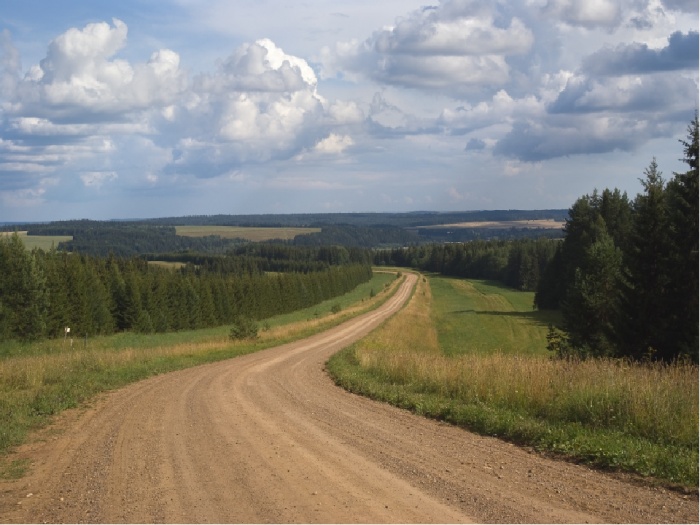
Due to certain circumstances, dirt roads continue to be very popular. To some distant settlements can only be reached by them. If left unreinforced, their cover turns to mush after heavy rains or a spring thaw. That is why their coating must be formed according to a specific profile. For this, soil is used, which is taken out after digging pits or channels. Those who used such types of coverage during the dry season know that it is problematic to drive in a column. The disadvantage is the rise of clouds of dust. Another disadvantage is the limited speed of movement after the formation of a deep rut.
To eliminate the shortcomings, various components are added. These may include gravel and sand. With their sufficient content, the road surface remains suitable for movement even in heavy rains. The best dirt roads are those built on clay layers. When laying gravel, coarse sand and other fastening components, good tamping and mixing is performed. Thus, relative solidity and better bearing capacity are achieved.

Dirt roads have certain restrictions on patency. The norm is the figure of 100 cars that cross carriageway per day. If such a pavement is subjected to more intense impact, then it loses its properties and requires the laying of asphalt or other components. Since there are no restraining supports, expansion of the web can occur by reducing its thickness. Therefore, they constantly add and level the surface with graders or tractors.
Note! To increase the patency of dirt roads, a bituminous base or cement is added to the bulk coating. In this case, the passage of up to 500 vehicles per day is allowed. But it still remains a problem for freight transport with high axial load.
Coating with organic ingredients
Capital roads require significant costs, which are expressed in man-hours, as well as in hours of consumable equipment. In some places where the flow Vehicle does not exceed 3 thousand cars per day lightweight coatings are laid. In their structure, they resemble ground coatings, which are additionally reinforced. An impregnating material is laid on the top layer of the flooring, which holds the components together, preventing them from scattering and spreading. On these types of roads, it is possible to move trucks and other freight vehicles. Moreover, such a flow is unlimited by any time of the year.
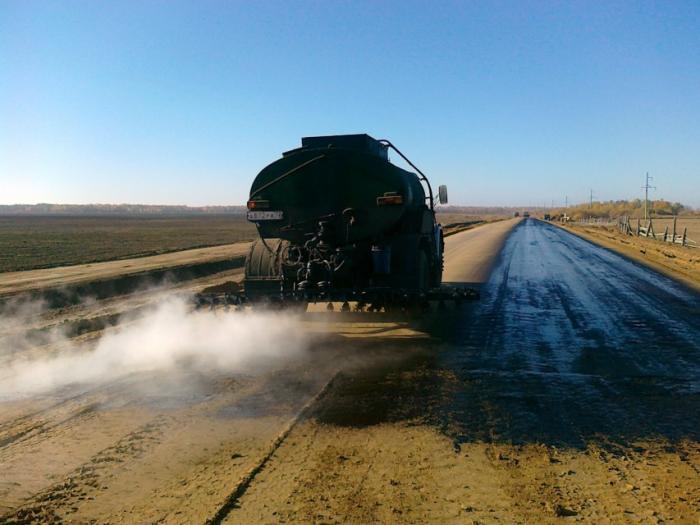
The basis of such a coating is crushed stone or gravel of a large fraction. A layer of coating from a smaller fraction is poured on top of it, and pebbles or small gravel serve as the final one. Bitumen or other organic binder is poured onto the prepared base. It ensures the evenness of the surface and its uniformity. At the same time, the road surface has some roughness, which is good for better grip and shorter braking distances. This kind of pavement has good water-repellent properties. The oil component does not allow water molecules to fix and penetrate into the pores. One of the disadvantages of such a coating is the mediocre stability at high temperatures. In hot weather, bitumen loses its strength and becomes more viscous. In such conditions, roads may be closed to heavy vehicles.
Note! Depending on the needs of a particular area, surface impregnation can be applied in one or two layers to the road surface.
Varieties of asphalt
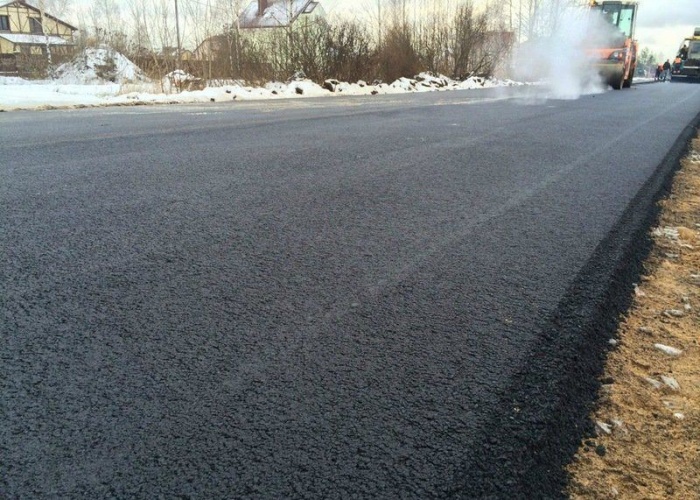
Asphalt is an improved version of the previous version of the road surface. The composition of the road surface also includes a bituminous base or tar base complete with various concrete and other additives. This type of road surface is the most common and is used on almost all major highways and expressways. The road easily transfers traffic intensity of 3 or more thousand cars a day. At the same time, the movement of equipment of various weight categories is allowed. There are three types of asphalt pavement:
- cold;
- warm;
- hot.
Much depends on the additives that are included in the road surface. For heating, specialized equipment is used, which is able to do this autonomously from a power source immediately before laying. The filler, which provides rigidity and stability of the road surface, is used in the form of crushed stone, stone powder rocks, impregnated with bitumen, gravel, coarse sand and others. The larger the fraction, the harder the road surface is and the less smooth it is. This is felt by the noise of the tires at medium and high speeds. Asphalt is never laid on its own. It is a rather elastic road surface that will not withstand the load exerted on it. To ensure stability, one or more layers of coarse crushed stone lining are used. In some cases, locally available pavement material is used, such as rock that has been crushed after blasting some minerals. The thickness of the underlayment pavement depends on many weather and landscape conditions.
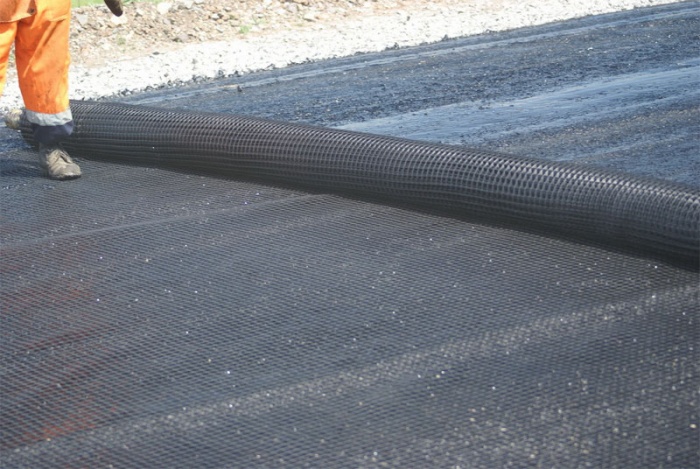
There are few drawbacks to such a road surface, but they still exist. All varieties of such road decks, which have a dark mineral component in their composition, absorb light well. This creates difficulties on sunny days, as the surface heats up to significant temperatures. The consequence is a reduction in the strength of such a road deck and negative impact on tires. At dusk, this is a problem, because the lights of oncoming cars are poorly visible. The solution to this issue for road decks is the use of reflective paint for markings, which allows you to better navigate. In some cases, the surface is made lighter by adding components that contain various calcium oxides.
In other embodiments, a layer of light-colored filler is laid on hot soft asphalt. With the help of rollers, it is simply pressed or recessed into the top layer. After setting, the surface of the road deck becomes monolithic and better reflects light. Incomplete clarification of the surface is allowed, but alternating. This approach to the roadway not only affects the characteristics of the deck itself, but also reduces driver fatigue. In areas with a monotonous landscape, the driver is less likely to lose vigilance and fall asleep.
Concrete plates
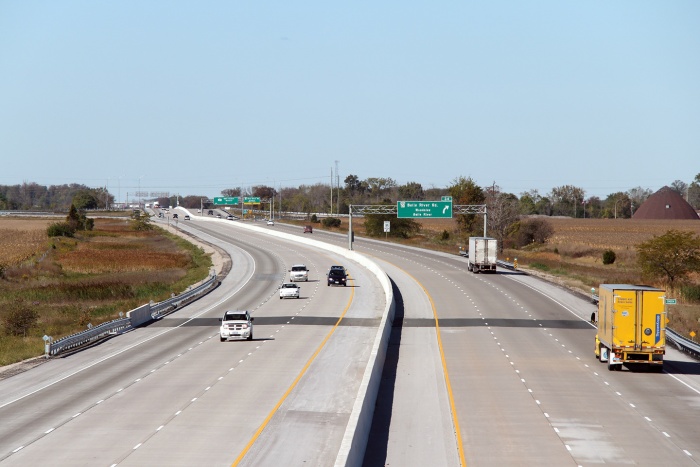
In some countries, the use of asphalt decks is not as common. Alternatively, roads with concrete pavements or cement concrete are used. They are not inferior in their characteristics and strength to various types of asphalt. Moreover, the maintenance of such road decks is cheaper, and the laying process is as automated as possible. During the processing of this type of road deck, a special rough texture is created, which provides excellent grip. At correct styling no other road can be compared to such a road deck in terms of evenness of the surface. Such coatings can easily withstand the workload of more than 3 thousand cars per day.
According to one type of technology, monolithic laying is performed concrete slab with continuous supply of cement concrete. In others, which are more common in our area, ready-made and cured slabs are delivered to the site. For maximum strength road decking, they can be vibrated or steam treated. This type of road deck also requires a stabilizing underlay or base. In its quality, various types of crushed stone, rocks, as well as coarse-grained sand are used. The use of the latter under such road decking is allowed in areas of low congestion. The thickness of the layer will depend on the specific conditions. The width of the lining under the road decking is made with a margin of 50 cm on each side.
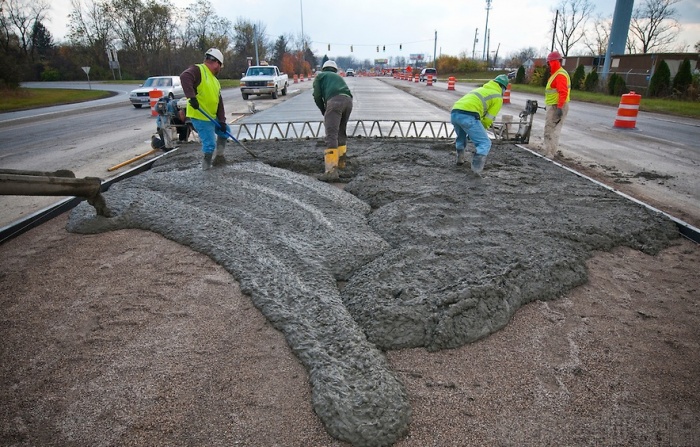
For cement concrete road decks, a careful selection of components and components is made. High demands are placed on cement, which is the main component. Its brand must be equal to or higher than M300. The thickness of such road decking can reach 24 cm along its entire length. At the same time, according to the technological process, the presence of a slope to the shoulders is implied. It is necessary so that liquid flows freely from the road.
Note! To increase the strength of the road surface along with a decrease in its thickness can be achieved by using a reinforcing mesh.
Temperature fluctuations have their effect on the road deck. If certain actions are not taken, then such a road deck will crack and become unusable. That is why every 80 or less meters a transverse incision of the road deck is made with a width of 3 cm. A special elastic material is placed in it, which will “play” during compression and expansion. Compression joints are another type of transverse joints in concrete pavement. They are located at a distance of up to 10 m and have a depth of up to 5 cm.

Note! In addition to longitudinal seams on the road deck, there are also longitudinal ones. They can be located in the middle of the slab if the total width of the road is 7 m. They can also be parallel to the axis, but interrupted every 3.5 m.
Operating process
Everyone knows what will happen to a house or any thing if it is left unattended. The laws of thermodynamics will certainly take effect and lead to partial or complete destruction. This factor does not bypass the road decks. Therefore, from time to time they need maintenance and repair. Maintenance may mean restoring the quality grip of tires to the road surface. To do this, ice and snow drifts are eliminated with the help of equipment and special chemical additives. In some areas, patching is allowed, which is designed to increase the evenness of the surface of the road deck.

In the rainy season, inspection and cleaning is carried out drainage systems located on road surfaces. If this is not done, then the liquid will accumulate in the layers of the flooring and, when exposed to a large weight, it can simply be washed away. In desert areas, where a large amount of dust can be applied to the flooring, it is treated with a special binder. It is calculated from the nominal flow rate per liter per square meter. This deck treatment guarantees increased comfort for the driver and mechanical parts while driving on the road deck.
Conclusion
As you can see, road decks have a complex structure, and also require a special approach during installation. The operation of the road surface includes a number of activities that should be carried out regularly. Only in this case it will be possible to talk about the long service life of the pavement. patching repairs road decks are allowed in cases where damage to the road deck is minimal. If extensive intervention is required to repair the road deck, part of the pavement is completely cut out and a new road deck is laid.
The practicality of many vehicles often depends on the quality of the road. Such structures are obtained in several ways, which leads to a significant difference in their technical parameters.
Non-rigid coatings
All types of roads can be divided into 2 main groups, these are structures with a hard and non-rigid surface. The last elements can be divided into several varieties:
- Crushed stone coverings. This type of surface involves the use of crushed stone as the main product for their coating. This type of road is used in microdistricts, parks or places where the use of better materials is not required, since they do not lend themselves to high loads.
- Gravel surfaces in most of their parameters resemble the previous type of products, but differ only in the material for manufacturing.
- Ground. This type of track is often decorative element parks. Such surfaces are not intended for constant and high loads.
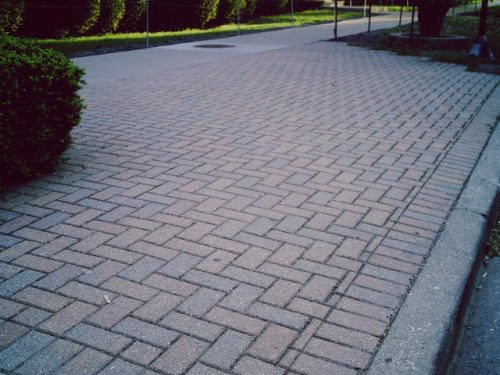
Rigid coatings
Roads of this type can be divided into several types:
- Prefabricated cement structures are often used in the manufacture of bridges. Differ in high resistance to loadings. Can be used in various weather conditions.
- Paved coverings. This type of expensive involves arranging them by laying natural stone. Today they are quite rare and are mainly used in the construction of paths in parks. Here the same paving stones are used, which fit tightly to each other.
- asphalt pavement. This type of road is one of the main ones. Today, the number of these coatings is huge, as they are relatively simple to arrange and can be used for quite a long time.
To increase durability, asphalt is laid on special cushions, as well as in several layers, depending on the size of the fraction. used as connecting elements. different types resins that tolerate temperature fluctuations well.
It should be understood that all these types of road surface allow only certain types of transport to be operated on them. Therefore, this is taken into account when laying them, which led to their diversity.
O protective coatings for asphalt - in this video:
Send your good work in the knowledge base is simple. Use the form below
Students, graduate students, young scientists who use the knowledge base in their studies and work will be very grateful to you.
1. Introduction
4. Conclusion
5. List of used literature
1. Introduction
To ensure the year-round movement of cars on the roadway, pavement is arranged, which is a solid monolithic structure laid on the surface of the subgrade made of materials that resist well climatic factors and vehicle wheels.
The stresses that arise in the road pavement during the passage of cars attenuate with depth. This makes it possible to design multi-layer pavement, using materials of different strength in its individual layers in accordance with the existing forces and the intensity of the influence of natural factors.
In road clothes, the following layers are distinguished:
Coating - top, most durable, usually waterproof, relatively thin layer clothing, well resisting abrasion, shock and shear loads from the wheels, as well as the effects of natural factors. Since the coating is made from the most expensive materials, it is given the minimum allowable thickness. The coating provides the necessary performance roads (flatness of the surface, high coefficient of grip with the tire). The pavement design, in addition to the main layer that provides the necessary qualities, provides for a spare layer (wear layer) that is not included in the design thickness and is subject to periodic restoration during the operation of the road.
On top of coatings that do not have sufficient water resistance and abrasion resistance, thin protective layers (surface treatment layers) are arranged by pouring organic binders with backfilling with one-dimensional fine gravel. Surface treatment is also used to increase the roughness of smooth coatings during operation;
Base - a load-bearing strong part of clothing, made of stone materials or soil treated with binders. It is designed to transfer and distribute pressure to the additional layers of clothing located below or to the subgrade soil (underlying soil) and therefore must be monolithic, resistant to shear and bending. The base is not directly exposed to the wheels of cars, and the influence of weather factors is transmitted to it in a somewhat softened form. Therefore, for its device, it is possible to use materials of lower strength than in the coating and wear layer. Widespread use for it should find local materials - durable industrial waste, weak stone materials treated with binders.
The base may consist of one or more layers. In the latter case, the upper layers of the base are made of more durable materials. The base, isolated during the installation of improved coatings from the effects of surface moisture, can be moistened as a result of the movement of moisture from the bottom up from the subgrade during the winter freezing period. Therefore, in the northern regions of the country, requirements for frost resistance are imposed on the materials for the foundation device;
Additional base layers of moisture-resistant materials are laid between the base of the coating and the underlying soil of the subgrade in areas with unfavorable climatic and soil-hydrological conditions. In places where the subgrade is composed of silty, loamy and clayey soils, in which winter moisture accumulation and heaving processes can develop, an additional layer of porous materials (sand, gravel or crushed stone) is introduced, which is called draining, anti-heaving or frost protection. This layer is designed to drain excess water from upper layers subgrade;
Subgrade soil (underlying soil, "working layer" of the subgrade) - carefully compacted and planned upper layers of the subgrade, on which layers of pavement are laid. All the pressure from traffic loads is transferred to the underlying soil, so it is a very important element of the pavement design. The strength of the pavement can only be ensured on a homogeneous, well-compacted subgrade that is not subject to heaving with adequate drainage. Increasing the soil resistance of the subgrade to external loads, its drainage and the constancy of the water regime are the most reliable ways to increase the strength of the road pavement and reduce its cost. No increase in the thickness of the layers of stone materials can ensure the strength and evenness of the pavement laid on a weak, uncompacted or waterlogged soil base.
2. Classification of pavement
Road clothes are divided into capital, lightweight, transitional and lower. Each of these types of pavement includes pavements various kinds(Table 2.10).
Road pavement must provide high reliability and the required transport and operational performance during the service life (between major repairs).
For capital types - 15 years.
For lightweight types - 10 years.
For transitional types - 6-8 years.
Distinguish between rigid and non-rigid pavement.
Rigid road clothes should include clothes that have:
Cement-concrete monolithic coatings;
Asphalt concrete pavements on cement concrete bases;
Prefabricated pavements made of reinforced concrete and asphalt concrete slabs.
3. Main types of road surfaces
Permissible speed and ease of movement are determined mainly by coatings, which can be divided into basic structural types.
Asphalt concrete is an artificial construction material, which is obtained by compacting in a hot state a mixture consisting of a small-porous stone core selected in size - crushed stone or gravel and sand, interconnected by a mixture of fine mineral powder with bitumen, introduced depending on the composition of the asphalt concrete mix in an amount from 3.5 to 9%. There are coarse-grained, fine-grained and sandy asphalt concretes. A feature of asphalt concrete is the dependence of their properties on temperature.
Cement-concrete pavements have high solidity and high load resistance. They are built in the form of separate slabs with dimensions in terms of 3: 4 or 6: 7 m with a thickness of 18 to 24 cm. The slabs are separated from each other by seams necessary to compensate for changes and lengths with temperature fluctuations. There are expansion joints, which contract when the plates are lengthened, and compression joints, which expand when the plates are shortened. To ensure the joint work of plates and save them relative position steel rods are introduced into the seams - pins, which provide the ability to change the length of the plates and transfer vertical loads and partially bending moments from one plate to another. The properties of cement concrete coatings do not change with temperature fluctuations. At correct selection the composition of the concrete mixture and compliance with the technological rules of construction, the wear of cement concrete pavements is negligible, and they are more durable than other types of pavements.
Impregnation - the introduction of emulsions or heated viscous bitumen and tar into the coating by spilling over the surface of an incompletely rolled layer of crushed stone of the same size. Crushed stone and gravel pavements treated with organic binders resist well the destructive effect of vehicle traffic due to the strong bonding of stone particles introduced by the binders. These clothes are waterproof.
Surface treatment - a thin protective layer created on the surface of the pavement by pouring 2 - 2.5 l/sq.m of bitumen, followed by backfilling with very fine crushed stone and rolling.
Crushed stone pavements have low wear resistance when passing cars, since the tangential forces that occur in the contact zone of pneumatic tires with the pavement disrupt the rolling effect. Therefore, as independent type crushed stone coatings are used only at low traffic intensity.
Bridges - coverings and bases, arranged from separate natural or artificial stones installed close to each other.
Improved pavements, made of paving stones or clinker, have a flat surface. Pavements made of rough chipped or boulder stone (cobblestone pavements) are sometimes used on roads of categories 2 and 3 as a temporary type pavement or as a base for more advanced types of pavements, and on roads of lower categories - as an independent type of categories.
4. Conclusion
One of the main transport and operational characteristics of the road surface is its evenness. It is customary to evaluate it using the evenness coefficient, which is the ratio of the sum of the heights of the pavement irregularities on a given section of the road to its length. The evenness coefficient is determined as the sum of the vertical displacements of the vehicle axle during the suspension compression stroke (in centimeters) per 1 km using a push gauge. The latter consists of a vertical toothed rack, connected in the lower part through a ball joint with the axle of the car and engaged with a gear wheel, which transmits movement to the counter through a ratchet clutch. The latter, thanks to the clutch, turns in one direction and thus registers the sum of the vertical displacements of the axle during the compression of the suspension. Coatings various types have different coefficients of evenness. So, for new asphalt concrete pavements it is 25 ... 50 cm / km, for cement concrete - 50 ... 100 cm / km (affects the presence of transverse seams).
The speed of movement significantly depends on the evenness of the surface (Fig. 2.9): On roads with uneven surfaces, the speed of the car is determined not by its dynamic qualities, but by the smoothness of the ride due to the need to ensure the safety of the cargo, the car itself and the comfort of the trip.
The type of coating (mainly its evenness) also affects the service life of vehicles, largely determining the mode of operation of its units and mechanisms. Prof. E.S. Kuznetsov provides the following data (Table 2.11).
Vehicles intended for operation on roads with low pavement evenness parameters must be designed with an increased margin of safety of parts, which naturally leads to an increase in their own weight and a deterioration in performance such as mass use and fuel efficiency.
Below are the transport and operational characteristics of the main types of coatings in comparison with asphalt concrete (Table 2.12).
5. List of used literature
1. Highways. Design and construction. Ed. V.F Babkova, V.K. Nekrasov and G. Shcheliyanov. M.: Transport, 1983
2. Belyatynsky A.A., Taranov A.M. Determining Visibility in Design highways. Kyiv. 1983
3. Saradarov A.A. Road architecture. M.: Transport, 1986
4. Babkov V.F., Andreev O.V. Road design. Part 1: Textbook for universities. - Ed. 2nd, revised and additional. - M.: Transport, 1987
Similar Documents
History of technology development road construction in Russia. Progress in the construction of subgrade and pavement. The advent of the automobile and the improvement of road networks. Application of bituminous emulsions. Modern stage road construction.
presentation, added 01/31/2017
Evaluation of the security of the design speed, road safety, the level of traffic congestion on the road, the evenness of the road surface. Determination of the actual modulus of elasticity of non-rigid pavement. The essence of the maintenance of roads and road structures.
term paper, added 12/08/2008
Calculation of pavement of non-rigid and rigid type. Selection of pavement structures in accordance with the requirements for the thickness of the layers, the elastic moduli of adjacent layers, the strength of the base of the road structure. Technical and economic comparison of road types.
term paper, added 12/14/2014
A motor road as a complex of complex engineering structures that provides safe movement traffic flow. Security traffic. Classification of road barriers. Regulations that govern their quality.
abstract, added 01/11/2011
Treatment of road surfaces with sand-salt mixture. Stabilization of predetermined densities of road treatment and methods of influencing ice. Treating the road surface with sand or other technological materials distributor PR-53.
term paper, added 02/18/2013
Appointment of road service. Construction and maintenance of state highways common use. Structure of Zhibek-Transservice LLP. Specifications motor grader. Asphalt technology. The main types of bulldozers.
practice report, added 09/15/2015
Schemes of the movement of vehicles. Basic parameters and design of roads of different categories. Approximate distribution of career roads by category and average speed movement. The main types of road surfaces. Maintenance and repair of quarry roads.
abstract, added 04/11/2009
Requirements for sites for measurements. Determining the evenness of the road surface using a 3-meter rail. Types of asphalt concrete and monolithic concrete pavements. Determination of the adhesion coefficient of the road surface.
laboratory work, added 01/26/2011
Methods and instruments for examining potholes, swells, subsidence and rutting. Determination of the roughness of road surfaces by the "sand spot" method. Method for determining the coefficient of adhesion by a percussion device of the PPK type and a pendulum type device.
abstract, added 12/23/2013
Road conditions as a factor determining the reliability of the driver. Evaluation of the impact, quality, correct installation and information content of road signs and other structures on road safety. Appointment and classification of road signs.
Introduction………………………………………………………2
1.General position………………………………………………………………………………………………
2. Device of the road surface………………………..4
3. Operation of the road surface……………………5
4. Classification of road surface…………………7
4.1. Coatings built using organic binders………………………………………….7
4.2. Asphalt concrete and tar concrete pavements…9
4.3 Dirt roads. Crushed stone and gravel…
………………………………………………………………….11
4.4. Cement-concrete coatings………………………….13
4.5. Bridge………………………………………………..15
4.6. Gravel coatings……………………………………………………16
4.7.Crushed stone coatings………………………………………………17
5. Structural layers of pavement……………..19
Conclusion…………………………………………………...22
List of information sources used……
…………………………………………………………………..23
Introduction.
Highways are of great economic, social and defense importance for the country. The state of the road economy is one of the most important indicators characterizing the level of development productive forces society.
A dense network of highways that meets the requirements of traffic flows makes it possible to rationally transport goods and passengers, draws the resources of individual regions into economic circulation, and creates conditions for saving public time.
The growth in the carrying capacity and speeds of vehicles requires the continuous development of the road network, the improvement of pavement designs. The inconsistency of the road condition with the requirements of the traffic flow reduces the speed of movement, increases the wear and tear of cars and the cost of their repairs, increases fuel consumption and tire wear, and contributes to an increase in the number of traffic accidents.
1. General position.
The road construction consists of technological processes performed in a certain sequence and requiring large expenditures of material and labor resources. The reduction of these costs can be achieved by the widespread introduction of complex mechanization and automation of production processes.
Significant changes have taken place in the field of integrated mechanization and automation. Thus, in the construction of roads with cement concrete pavement, a new technology for pavement in sliding formwork was introduced, which almost completely replaced the technology for pavement in stationary formwork, which made it possible to increase the pace of construction by several times, reduce labor costs and significantly improve the performance of roads. The introduction of this technology became possible thanks to the creation of a new set of machines with sliding formwork. All machines of this set are equipped with automation systems. To provide a set of machines with road construction materials, new high-performance cement-concrete plants and soil-mixing plants have been created.
Significant changes have also taken place in the technology of building roads with asphalt concrete pavements. The new pavers make it possible to provide a higher degree of pre-compaction of asphalt mixtures, which not only reduces the cost of their further compaction, but also improves the quality of the pavement. Asphalt pavers are equipped automatic systems providing a longitudinal and transverse profile and blocking the travel drive and working bodies.
2.Paving device
Motor roads consist of a subgrade with artificial structures, a carriageway and roadsides. The stability of the subgrade is achieved by laying it out of solid soils and devices for the removal of surface and groundwater.
The width of the subgrade consists of the width of the carriageway and its two shoulders.
The carriageway is covered with pavement. Pavement is made in one or more structural layers. Multilayer pavement is usually installed on permanent roads and has the following main structural layers:
Pavement - the top layer of pavement, which in turn consists of a wear layer, periodically renewed as it wears out, and the main layer that determines the performance properties of the pavement.
The base is the bearing part of the pavement, which, together with the coating, ensures the transfer of loads to the underlying layer or directly to the subgrade soil.
Additional base layer - the lower structural layer of the pavement, which, along with the transfer of loads to the subgrade, also functions as a frost-protective, draining, leveling and other layers.
The base materials are crushed stone, crushed stone, gravel, soil treated with binders, and for an additional layer - coarse sand, gravel soils, crushed rock and other local materials.
3. Operation of the road surface.
The strength of the pavement is achieved by restoring the wear layer, evenness - by eliminating irregularities, wheel adhesion with the coating - by removing snow and dirt, sprinkling with sand, small gravel, etc. Dust removal is carried out by treating the coatings with black binders (bitumen, road tar) and dust-binding materials. The evenness of the coating determines the speed of the vehicles.
In the spring-autumn period, it is important to maintain the transverse profile of the subgrade, which ensures the flow of water through the drainage structures. Variable loads from wheels with different traffic intensity cause waves and shifts on the surface. AT summer period importance has the prevention of dust on the roads, tk. dust worsens the working conditions of drivers and increases the wear and tear of vehicles.
In order to remove dust, it is recommended to spray a dust-binding substance onto a previously leveled dry surface of the coating with watering machines. The consumption of dust-binding substances is 0.5-1.5 l per 1 m 2 of coating, and the duration of dust removal is 15-100 days, depending on the type of material.
AT winter period Of particular importance are the works on clearing roads from snow and the fight against ice. Moreover, it is necessary to ensure the coefficient of adhesion of the wheels to the road is not less than 0.3. Snow removal is carried out by bulldozers, graders, snowplows, of which rotary and milling-rotary are the most effective, because. able to develop packed masses of snow. The fight against glaciation is carried out by scattering bulk materials(sand, ash, boiler slag, gravel, etc.) with an approximate consumption of materials - 0.1-0.4 m 3 per 1000 m 2 of coating or processing chemicals, destroying the crystal structure of ice ( salt, calcium chloride, etc. in the composition of 50 g / l) with a solution flow rate of 120-200 l / m 2 (to prevent corrosion of machines and mechanisms, up to 7% of anti-corrosion additives are introduced into the solutions).
To current repairs include works on the prevention and elimination of minor damage to the road and road structures: repair of cracks and potholes, correction of subsidence, backfilling of potholes, road grading, repair of damage to the subgrade,
cleaning roads from dirt, etc.
Average repair is carried out 1-2 times a year and includes work to eliminate road wear: surface treatment of asphalt concrete, black, crushed stone and gravel coatings, replacement of individual slabs, leveling of coatings with the addition of crushed stone or gravel, surface treatment of the road.
4. Road surface classification
4.1 Coatings built using organic binders
With the use of organic binders, improved coatings of both lightweight and capital types are arranged. Improved lightweight pavements are arranged on roads with a traffic intensity of 500 to 3000 vehicles per day. The most widespread are improved lightweight coatings, arranged according to the method of surface treatment, impregnation or mixing. They have a smooth, non-slip and dust-free surface that allows the movement of vehicles at high speeds. Their design ensures the movement of heavy vehicles throughout the year.
Surface treatment. Surface treatment is arranged to create a mat on the surface of finely crushed stone material treated with bitumen. Such a mat protects the coating from wear, increases the roughness, evenness and water resistance of the pavement. Rough surface treatment is used both in the construction of new clothes and in the restoration of roughness on the worn slippery surface of existing coatings. The surface treatment device must first of all be provided for in the following sections: on slopes, on horizontal curves of a small radius, at intersections at the same level, as well as on approaches to these sections at a distance of at least 50-100 m and on other difficult sections of the road.
Depending on the purpose, surface treatment can be single or double.
4.2. Asphalt concrete and tar concrete pavements.
Asphalt concrete and tar concrete pavements are classified as improved capital type pavements, they are arranged on roads of categories I, II, III with a traffic intensity of more than 3,000 cars per day. These coatings are made from hot, warm and cold asphalt or tar mixes prepared in plants. Asphalt concrete, depending on the type of stone material, is divided into crushed stone, consisting of crushed stone, sand, mineral powder and bitumen; gravel, consisting of gravel, sand or gravel-sand material, mineral powder and bitumen; sandy, consisting of sand, mineral powder and bitumen.
Asphalt concrete pavements are arranged as single-layer and double-layer on stone and concrete bases. For better adhesion with asphalt concrete, stone bases are treated with bituminous or tar materials. The number and thickness of the layers are usually set for constructive and economic reasons and are checked by strength calculations.
The disadvantages of asphalt concrete pavements include: dark color, which creates high light absorption, which can cause accidents in the evening. During the construction of asphalt concrete pavements, it is possible to use an illuminator, as a result of which an increase in the brightness of the pavement at night and an increase in its reflective ability is achieved. For this purpose, light natural or artificial crushed stone is used to prepare the asphalt concrete mixture.
Clarification of the asphalt concrete pavement is possible by surface treatment with the device of a wear layer of light materials.
The arrangement of a layer using light materials can be carried out by embedding light material into undercompacted asphalt concrete, followed by additional compaction or gluing of light material to the surface of the asphalt concrete pavement using mastics.
Changing the color of the road surface with alternating coloring reduces driver fatigue in areas with a monotonous landscape, increases the driver's attention and helps to better navigate. For the device of such coatings, colored plastic concretes are used, which are a compacted mixture of crushed stone, sand, mineral powder, pigment dye and binder, taken in certain proportions.
4.3 Dirt roads. Crushed stone and gravel coatings
Dirt roads. Unpaved roads are roads constructed from natural soil and soil reinforced with additives of other materials. The surface of the road is given a convex profile, which is created using imported soil or soil obtained during the installation of drainage ditches.
Depending on the properties of the soil, the road has greater or lesser stability, and, consequently, passability. A well-maintained dirt road during the dry season allows vehicles to pass at sufficient speeds. A big disadvantage of dirt roads is their dustiness. During the period of autumn and spring thaws, due to waterlogging of the soil and loss of bearing capacity, dirt roads become impassable, as deep ruts, potholes and potholes are formed under the influence of car wheels.
To improve the passability, dirt roads are strengthened with additives. Observations show that soils with a coarse-grained skeleton containing coarse sand and gravel particles of 45–75% and clay particles of 6–12% do not get wet and do not lose their bearing capacity even with significant moisture. This composition of the soil is called optimal.
If the natural soil of the carriageway differs in composition from the optimal mixture, the missing particles are added to it and brought to optimal composition. When introducing additives into natural soil, good mixing, thorough profiling and compaction must be ensured.
Improved dirt roads keep the profile well and provide passage at a traffic intensity of up to 100 vehicles per day. With more intensive traffic, the road surface is deformed and requires enhanced grading work. The improved dirt roads cannot withstand the movement of heavy vehicles. Profiling (flattening) of dirt roads must be carried out systematically, especially after rains.
It is possible to more reliably increase the water resistance of soils and their cohesion by introducing additives of mineral (cement, lime) and organic (bitumen, tar) binders. The most suitable for processing with additives of binders are sandy loamy soils and soils of optimal granulometric composition. Soils treated with additives become stable and are used for coatings at a traffic intensity of up to 500 vehicles / day.
4.4. Cement-concrete coatings.
Cement concrete pavements are installed on roads of categories I, II and III with high traffic intensity (more than 3000 cars per day). The advantages of cement-concrete pavements are high strength, evenness and at the same time sufficient roughness, which ensures good adhesion of car tires to the road surface.
Cement-concrete pavements are increasingly being used due to their cost-effectiveness and ease of use. The production of works on the installation of cement concrete pavements is almost completely mechanized.
Cement-concrete pavement is a concrete slab laid on a solid and stable base. As bases for concrete coatings, soil layers reinforced with binders, coarse-grained or medium-grained sand, crushed stone, gravel or gravel-sand mixture are used. Cement-concrete pavement on a sandy base may only be laid on category III roads and at reduced intensity on category II roads. The foundations are arranged 0.5 m wider than the carriageway on each side.
The concrete used to make the slabs is a rationally selected mixture of crushed stone, sand, cement and water. The strength of such a mixture is characterized by compressive strength after 28 days of hardening. The brand of concrete is determined precisely by this characteristic and for road surfaces it must be at least 300.
The thickness of the concrete slab is determined by calculation, taking into account the size and nature of the movement. Typically, the slab has a thickness of 18-24 cm within the entire width of the carriageway and a transverse slope for water runoff of 10-15%.
The thickness of the concrete slab can be reduced by applying prestressing reinforcement to prestress the concrete to be placed.
To protect the plate from the formation of cracks during temperature changes, expansion joints are arranged. Expansion joints (transverse), providing elongation of the slab, have a gap of 2.5–3 cm and are arranged every 20–80 m.
Compression joints (transverse) protect the slab from cracks that occur when the temperature drops, they are cut to a depth of 5 cm 1 cm wide after 4-10 m. The distance between the transverse joints depends on the type of base, slab thickness and air temperature during concreting.
Longitudinal seams are made along the axis of the roadway with a width of 7–7.5 m or parallel to the axis through 3.5–3.75 m. pin laying. The pins prevent transverse displacement of the plates at the seams and at the same time allow them to move in the longitudinal direction. To ensure water tightness, the seams are filled with elastic material or special mastic.
In some cases, pavements are made with steel reinforcement, mainly to prevent cracking. If the coating is arranged in two layers, then metal mesh placed between the first and second layers.
It is possible to install cement-concrete coatings from ready-made reinforced concrete slabs that are transported to the place trucks and laid on a pre-prepared base with truck cranes. The complexity of the installation and transportation of plates large sizes does not allow this method to be applied on a large scale.
4.5. Bridges.
A pavement is called a coating consisting of a piece of stone.
The materials used for pavements are natural and artificial.
Checker belongs to natural correct form(paving stones, mosaic checker), made from durable rocks of stone, or a coarse checker, which has approximately the shape of a truncated pyramid and a height of 14-18 cm. be used for bridging. The construction of the bridge requires a qualified manual labor.
The surface of the pavement is uneven, the speed of vehicles on it is limited, so pavements are becoming less and less used.
Improved paving stones and mosaics are used only in urban areas. High strength, durability in some cases justify the high cost of their construction. Such bridges provide a traffic intensity of more than 3,000 vehicles per day with design speeds for roads of categories I-III. The complexity of mechanization, a large amount of manual labor does not allow them to be used on a large scale on country roads.
4.6. Gravel coatings.
Gravel coatings are of a transitional type, they are arranged on roads with low traffic intensity (up to 500 vehicles / day). In good condition, the gravel surface provides a speed of up to 70 km/h.
Gravel mixtures are found in nature in the form of natural deposits containing particles of rock fragments of various sizes. For the pavement, the gravel material must meet the requirements of an optimal mixture and be selected according to the principle of greatest density. Its composition should contain a sufficient amount of fine earth (clay and dusty particles), which fills the voids between large particles and, when the mixture is wetted during the period of coating compaction, seems to cement large particles together. Gravel coverings arrange a sickle-shaped or half-trough profile directly on the subgrade or on the underlying layer of sand. The thickness of the gravel cover, depending on the traffic conditions, is 8-16 cm single-layer and 25-30 cm double-layer. For the lower layer, it is possible to use mixtures with a grain size of up to 70 mm, for the upper layer - no more than 25 mm.
During the period of operation, gravel coatings require proper maintenance. Irregularities are corrected by ironing or profiling with motor graders when the coating is wet.
4.7.Crushed stone coatings.
Crushed stone pavements, as well as gravel, are arranged on roads of categories IV and V with low traffic intensity (up to 200 cars per day). For the device of crushed stone coatings, artificially crushed stone material, more often limestone, having a compressive strength of at least 600 kgf / cm2.
For the lower and middle layers of crushed stone bases and coatings, fractionated crushed stone with a particle size of 40-70 and 70-120 mm is used; for the upper layers of bases and coatings - 40-70 mm; for wedging - 5-10, 10-20 and 20-40 mm. Crushed stone of weak rocks is used with a size of more than 70 mm.
Crushed stone coating is arranged on a sandy underlying layer. Other local materials (slag, shell, gravel) can be used for the foundation.
The principle of the crushed stone coating device is as follows. Crushed stone with a particle size of 40 mm and above is scattered on a pre-prepared base, leveled according to a given profile and pre-compacted with rollers until the crushed stone is immobile. Then, for wedging, smaller stone material is successively scattered - crushed stone with a particle size of 10-20 mm and 5-10 mm. Rolling achieve complete jamming of gravel. When rolling, crushed stone is watered, which facilitates the mobility of crushed stones during rolling and contributes to cementation and better formation of the coating.
Crushed stone coating is arranged in a trough profile in one layer 10-18 cm thick, and with a thickness of more than 18 cm - in two layers. For the lower layer, less durable crushed stone is used. The coating surfaces are given a transverse slope of 30% o-
The crushed stone coating wears out rather quickly and is not stable during car traffic. Tangential forces from the wheels of a moving car upset the cohesion of the gravel, as a result of which the coating quickly collapses. To increase the cohesion of crushed stone, the water resistance of the coating and eliminate dustiness, crushed stone is treated with bituminous and tar materials.
5. Structural layers of pavement
Pavement is arranged on a planned and compacted subgrade surface, it must ensure the movement of vehicles of a given weight at a calculated speed and be sufficiently resistant to the influence of climatic factors.
Depending on the thickness and materials used, pavement can be placed on the subgrade along a sickle-shaped, semi-trough or trough profile.
The crescent profile is used mainly on roads of lower categories. For the installation of crescent-shaped coatings, local materials are used: gravel, soil and others, reinforced with various additives. With a sickle-shaped profile, pavement is arranged for the entire width of the earthen bed. The thickness of clothing, greatest in the middle, is gradually reduced to 3-5 cm at the brows.
Road pavement can be of different strength depending on the intensity and composition of traffic, traffic density, design speed and must meet the following requirements: its strength must ensure the absence of subsidence and high wear resistance; The evenness of the surface must allow movement with high speeds; The surface roughness should ensure good adhesion of the coated vehicle wheels.
One of the main conditions for improving traffic safety is to reduce the slipperiness of the road surface. An analysis of traffic accidents shows that in the summer of accidents due to the slipperiness of coatings, 4-16% occur, and in autumn and spring 40-70%.
The reason for the increase in slipperiness may be dirt brought onto the roadway from the shoulders, unreinforced ramps or junctions, which sharply reduces the grip properties of the coating. To prevent the drift of dirt onto the roadway, roadsides, ramps and junctions are strengthened.
The surface roughness of the pavement of the roadway must provide a coefficient of adhesion car tire with a coating surface in the wet state of at least 0.5. To create a rough surface arrange surface treatment.
The main factors on which the choice of pavement design depends are the intensity and composition of traffic. The greater the intensity of traffic on the road, the faster the coating wears out, therefore, with a high traffic intensity, a more thorough, durable and perfect coating should be arranged. On roads with less traffic, the pavement is subject to less wear and therefore it can be of a lighter type. In those cases where the intensity of traffic in a given period is small, but it is expected to increase in 5-10 years, transitional-type pavements are arranged, which, after strengthening, can be classified as improved. At low traffic intensity, cover of the lowest type is suitable.
Conclusion
Nowadays, the road construction industry is being introduced Newest technologies and development. Currently, in Belarus, the problems associated with the construction and operation of roads are the most significant. The country's economy is stabilizing, and the standard of living of Belarusians is rising accordingly. The purchasing power of people is increasing, therefore, there are more and more cars on our roads.
To date, the quality of roads for the most part does not meet the requirements of car owners. In this regard, the government of Belarus pays great attention to the problems of construction and operation of roads.
List of used information sources.
1. http://revolution.allbest.ru/transport/
2. http://www.lib.ua-ru.net/diss/
3. http://www.usecar.ru/page22
4. http://otherreferats.allbest.ru/transport/
5. Kabanov V.V., Kirillova L.M. The device of road surfaces. M ‘‘Transport’’, 1992. - 262 p.
6. Glagoleva T.N., Garmanov E.N. and other Handbook of a road engineer. 3rd edition, revised and enlarged. M ‘‘Transport’’, 1977. - 560 p.
Content. Introduction ................................................ ..............2 1.General position ............................... ..................3 2.Paving arrangement .............................. ..4 3. Maintenance of the road surface





